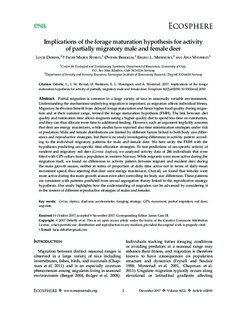| dc.contributor.author | Debeffe, Lucie Isabelle | |
| dc.contributor.author | Rivrud, Inger Maren | |
| dc.contributor.author | Brekkum, Øystein | |
| dc.contributor.author | Meisingset, Erling L. | |
| dc.contributor.author | Mysterud, Atle | |
| dc.date.accessioned | 2018-03-15T08:50:05Z | |
| dc.date.available | 2018-03-15T08:50:05Z | |
| dc.date.created | 2018-01-09T12:26:23Z | |
| dc.date.issued | 2017-12-21 | |
| dc.identifier.citation | Debeffe, L., I. M. Rivrud, Ø. Brekkum, E. L. Meisingset, and A. Mysterud. 2017. Implications of the forage maturation hypothesis for activity of partially migratory male and female deer. Ecosphere 8(12):e02050 | nb_NO |
| dc.identifier.issn | 2150-8925 | |
| dc.identifier.uri | http://hdl.handle.net/11250/2490614 | |
| dc.description.abstract | Partial migration is common in a large variety of taxa in seasonally variable environments. Understanding the mechanisms underlying migration is important, as migration affects individual fi tness. Migratory herbivores bene fi t from delayed forage maturation and hence higher food quality during migra- tion and at their summer range, termed the forage maturation hypothesis (FMH). The link between diet quality and rumination time allows migrants eating a higher quality diet to spend less time on rumination, and they can thus allocate more time to additional feeding. However, such an argument implicitly assumes that deer are energy maximizers, while studies have reported also time minimization strategies under risk of predation. Male and female distributions are limited by different factors linked to both body size differ- ences and reproductive strategies, but there is no study investigating differences in activity pattern accord- ing to the individual migratory patterns for male and female deer. We here unify the FMH with the hypotheses predicting sex-speci fi c time allocation strategies. To test predictions of sex-speci fi c activity of resident and migratory red deer ( Cervus elaphus ), we analyzed activity data of 286 individuals that were fi tted with GPS collars from a population in western Norway. While migrants were more active during the migration itself, we found no differences in activity pattern between migrant and resident deer during the main growth season, neither in terms of proportion of daily time active nor in terms of daily mean movement speed, thus rejecting that deer were energy maximizers. Overall, we found that females were more active during the main growth season even after controlling for body size differences. These patterns are consistent with patterns predicted from sexual segregation theory linked to the reproductive strategy hypothesis. Our study highlights how the understanding of migration can be advanced by considering it in the context of different reproductive strategies of males and females. | nb_NO |
| dc.language.iso | eng | nb_NO |
| dc.publisher | John Wiley and Sons | nb_NO |
| dc.rights | Navngivelse 4.0 Internasjonal | * |
| dc.rights.uri | http://creativecommons.org/licenses/by/4.0/deed.no | * |
| dc.subject | Cervus elaphus | nb_NO |
| dc.subject | dual-axis accelerometer | nb_NO |
| dc.subject | foraging strategy | nb_NO |
| dc.subject | GPS | nb_NO |
| dc.subject | movement | nb_NO |
| dc.subject | partial migration | nb_NO |
| dc.subject | red deer | nb_NO |
| dc.subject | ungulate | nb_NO |
| dc.title | Implications of the forage maturation hypothesis for activity of partially migratory male and female deer | nb_NO |
| dc.type | Journal article | nb_NO |
| dc.type | Peer reviewed | nb_NO |
| dc.description.version | publishedVersion | nb_NO |
| dc.rights.holder | © 2017 Debeffe et al. | nb_NO |
| dc.source.volume | 8 | nb_NO |
| dc.source.journal | Ecosphere | nb_NO |
| dc.source.issue | 12 | nb_NO |
| dc.identifier.doi | 10.1002/ecs2.2050 | |
| dc.identifier.cristin | 1538696 | |
| dc.relation.project | Norges forskningsråd: 179569 | nb_NO |
| dc.relation.project | Norges forskningsråd: 230275 | nb_NO |
| cristin.ispublished | true | |
| cristin.fulltext | original | |
| cristin.qualitycode | 1 | |

